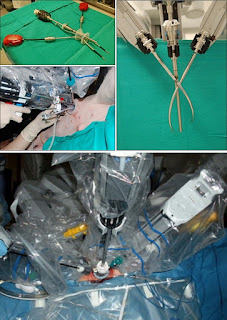Da Vinci for SILS
The community has been long fascinated with the idea how to use robotic manipulators--and especially the da Vinci--to compensate for the ergonomic difficulties in NOTES.
In the early experiments, groups tried to arrane the da Vinci robot in a twisted way to perform NOTES, e.g. "A single 12-mm trocar was placed in the midline, and two 12-mm standard laparoscopic ports were placed into the abdomen via the vagina and the colon. The robotic ports were then telescoped into the 12-mm ports, and the daVinci S robot was docked. Dissection was performed using the Hot Shears and the ProGrasp instruments. The robotic camera was placed via the midline port and held by an assistant. " (Box et al., 2008).
"Haber et al. adopted a different approach toward robotic NOTES in the porcine model, placing the robotic camera lens and one arm through the umbilicus, with the other robotic arm inserted through the vagina. Desai et al. performed transvesical robotic RP in a cadaver model with the a Kaouk et al reported in 2009 the first successful series of single-port robotic procedures in humans, including RP, dismembered pyeloplasty, and radical nephrectomy [86]."
Since classical tool manufactures started to come out with roticulators, steerable cameras and other pre-bent instruments (Dhumane et al., 2011), it was desired to create the same tools for the da Vinci as well.
The first solutions were published by Joseph et al.: "Cholecystectomy and nephrectomy were performed utilizing the chopstick technique: where the instruments are crossed at the abdominal wall so that the right instrument is on the left side of the target and the left instrument is on the right, preventing collision of the external robotic arms." The control on the consol has been switched as well.
The newer setup is the VeSPA tools from Intuitive for the SI system, and numerous experiments have been conducted on the porcine by Haber et al.: "The configuration of the current IS3000 da Vinci Si was modified with the intent to perform R-LESS surgery. The console and the slave remain the same and only arms 1 and 2 were used in addition to the camera arm. A newly designed prototype multichannel port (Intuitive Surgical) allowed the placement of an 8.5-mm scope, a 12-mm cannula for the assistant, and, more importantly, 2 crossing curved cannulae for the robotic instruments. The VeSPA instruments and accessories are of similar construction to existing da Vinci Si EndoWrist instruments, except for the shaft that is semirigid, allowing them to be inserted through curved cannulae. In addition, the instruments do not have a wrist at the distal end of the instrument. The VeSPA instruments and accessories include needle driver, Cadiere grasper, right-angle Maryland retractor, curved scissors, hook, clip applier, and suction irrigator."
Beyond robotics, some hand-hel devices also pushed the boundaries of SILS/LESS tools, such as SPIDER, USGI's Transport, or Direct Drive from Boston Dynamics. However, they are facing the same issues with the increased complexity and towering costs of the devices.
Image credit: European Urology, Haber et al.



Comments